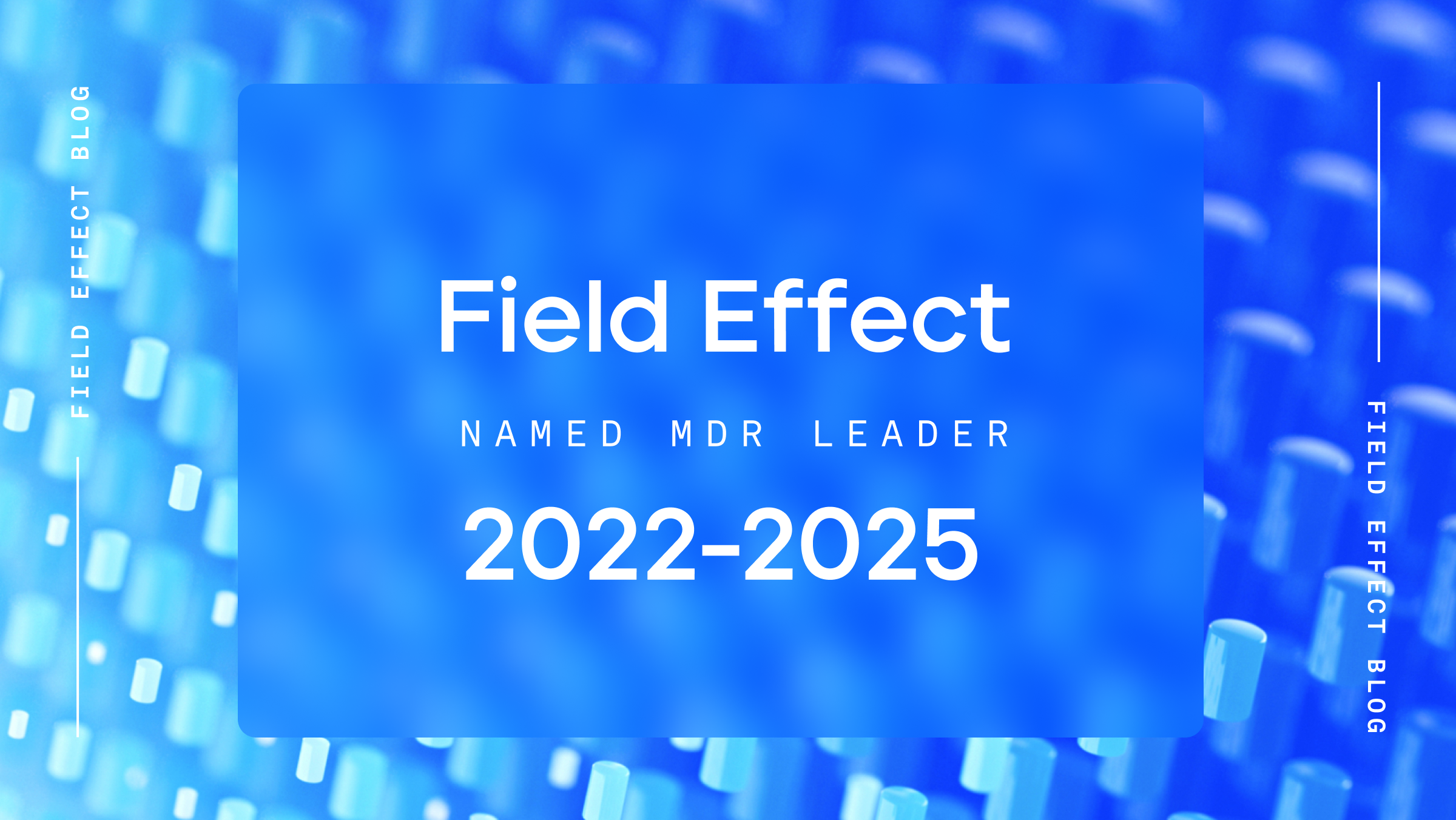
News
January 14, 2025 | News Products and services
By Field Effect
As we look back on an exciting and productive 2024 at Field Effect, we’re taking a moment to reflect on the strides we’ve made in enhancing our MDR service. Our mission has always been to provide you with the most advanced and reliable cybersecurity solutions, and this past year was no exception.
Since the beginning, you—our valued partners and clients—have been at the heart of everything we do. Your feedback drives us to continually improve and innovate, ensuring we deliver a solution you trust and enjoy using. This year, we focused on you even more, introducing powerful updates and new features designed to make your cybersecurity stronger, your insights clearer, and your experience smoother.
These updates and features sit nicely within three themes:
While this blog is not an exhaustive list of released features, it highlights those we feel may be particularly interesting to you. As always, Field Effect MDR customers can visit the Release Notes history in their Support knowledge base for a complete list.
Before we dive in, let’s shine a light on MDR Core, our newest cybersecurity offering for smaller organizations, or those with lower cybersecurity and/or IT complexity. Read up on the early adopter details here, and stay tuned as we gear up for a full launch.
Released in mid-Q4, Field Effect MDR Complete now includes monthly dark web scans, based on your/your customers’ domain(s), with a report detailing any exposed data within the last month.
We monitor thousands of dark web sources including forums, telegram groups, and other areas where actors coalesce to discuss/share breached and leaked data. The risk associated with any exposed data is also assessed based on how quickly, and the degree to which, the compromised data can be exploited.
In addition to the Common Vulnerability Scoring System (CVSS), we now provide Exploit Prediction Scoring (EPSS) and the vulnerability's presence on CISA's Known Exploited Vulnerabilities (KEV) catalog.
The CVSS assesses the severity of the vulnerability, the EPSS measures the probability of being affected by it, and the KEV catalog indicates to what extent the vulnerability is being exploited. The vulnerabilities are then prioritized based on these elements, to help you swiftly address the most critical vulnerabilities first.
Cloud Active Response actions were updated to allow for the blocking of accounts using conditional access policies.
With this update, when an M365 account is locked due to a security threat, this conditional access policy is also put in place to restrict access to any resources from that account, ensuring that the compromise is contained.
Our monitoring now extends to browser extensions in use across the network, and subsequent AROs for any malicious extensions identified.
Supported browsers include Chrome, Safari, Edge, Firefox, Chromium, Opera (inc. GX), Brave and Vivaldi across Windows, macOS, and Linux devices.
2024 saw the release of additional Active Response capabilities for Linux agents, so now Linux devices can be remotely isolated, rebooted, or shut down.
Additionally, Linux agents now also detect pkgs installed via Snap pkg manager, providing additional visibility of software running on Linux devices.
For those using Microsoft GCC, this can now be added to the cloud monitoring profile.
Note that the features below focus on visibility. Where any items below indicate compromise, Active Response and/or our ARO process will fire as appropriate.
You can now map Field Effect controls and NIST SP 800-171 Rev. 2. The former are a series of best practices drawing on the experience of Field Effect analysts and industry-leading frameworks.
Mapping these within the portal will add context within AROs if the issue impacts a given framework requirement or control.
There were several new reports and views added within the Field Effect Portal or the Appliance Dashboard. These views work to provide the relevant insights needed to proactively address vulnerabilities and identify risks. Current Field Effect MDR customers can learn more using the links below.
Providing insight into the various software installed across the network is always a focus of ours, and as such we added a few new areas of visibility:
Two-way integration of AROs with HaloPSA is available to our MSP partners, allowing technicians to manage AROs within their HaloPSA account, with lifecycle and comment synchronization back to the Field Effect Portal.
This is in addition to our existing ConnectWise and Autotask PSA integration, ensuring AROs meet MSP techs where they work.
This feature allows greater control of how partners are notified of malicious SEAS results. If this feature is enabled, an ARO will be generated when SEAS identifies an email as malicious or suspicious. This would then be sent via the PSA integration to ConnectWise, Autotask, or HaloPSA to promptly alert technicians.
Using this new portal, partners can better manage their users against their license allocation. This allows for the self-service creation of customer organizations and their users. It additionally provides clarity on the remaining license count.
Field Effect MDR customers can now access dozens of templates for various relevant cybersecurity policies from within the support portal. These templates will provide you with a starting point for Access Control policies, IR plans, Information Management policies, and more.
There are many reasons you may choose to dismiss or resolve an ARO, several of which directly impact how Field Effect MDR will treat related alerts in the future. To minimize noise and maximize transparency and efficiency between your team and ours, we added a more formalized and easy-to-follow structure when managing an ARO’s lifecycle.
This includes better communications with our analyst team for the reasons why an ARO has been dismissed or resolved, which helps us determine how to handle similar scenarios in the future.
You likely noticed a new help widget within your MDR Portal in the summer of 2024. This new widget provides contextualized help, providing suggested support articles based on where you are in the portal. If none of the suggestions are what you’re looking for, you can further search within the widget for additional articles.
While items here aren’t directly visible, you will undoubtedly benefit from their outcomes. We are always enhancing our analytic detections based on new or evolving intelligence, and looking at ways to increase efficiency in our service delivery.
Proudly, we saw the following stats through 2024:
We’re incredibly proud of the value these updates bring to our partners and customers. Every enhancement we deliver is designed to support you in the ever-changing cybersecurity landscape. Whether it’s strengthening defenses, delivering deeper insights, or enhancing experience, our goal remains the same: to empower you with the tools and knowledge to thrive.
Looking ahead to 2025, we’re excited to continue this journey with you. With new projects already underway—including expanded reporting capabilities and more—you can expect even more releases, updates, and improvements in the coming year.


